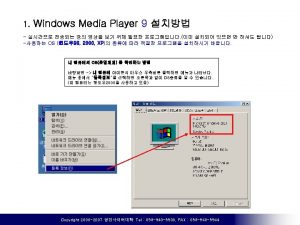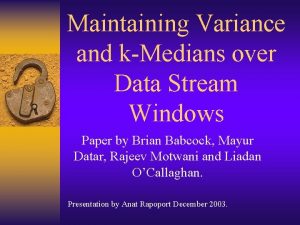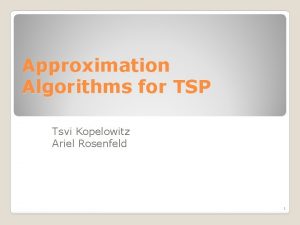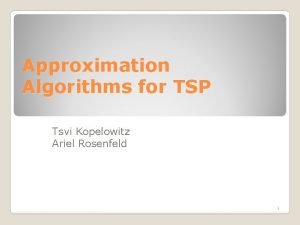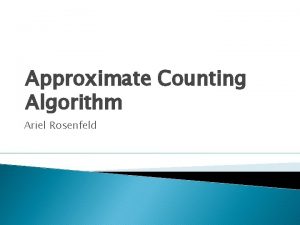Maintaining Stream Statistics over Sliding Windows Ariel Rosenfeld













- Slides: 13

Maintaining Stream Statistics over Sliding Windows Ariel Rosenfeld 1

Streams Here, There, Everywhere! 1 1 Network Traffic Engineering. 0 0 Call Record Analysis. 1 Sensor Data Analysis. 0 Medical, Financial Monitoring. Etc, etc. 1 0 1 1 1 2

Sliding Window Model Time Increases …. 1 0 0 0 1 1 1 1 0 0 0 1 1… Window Size = N Current Time 3

The Problem –Basic counting Count the number of ones in N size window. Exact Solution: Θ(N) memory. Approximate Solution: ? ◦ Good approx with o(N) memory? 4

Sliding Window Computation Main difficulty: discount expiring data ◦ As each element arrives, one element expires value of expiring element can’t be known exectly. ◦ How do we update our structure? One solution: Use Histograms … 1 1 0 1 0 0 0 1 0 Bucket sums = (3, 2, 1, 2) 5

Results Exponential Histogram (EH): ◦ 1 + ε approximation. (k = 1/ε) ◦ Space: O(1/ε(log 2 N)) bits. ◦ Time: O(log N) worst case, O(1) amortized. 6

Histograms (remainder) 7

Example k/2 = 1. Bucket sizes = 4, 2, 2, 1. 4, 2, 2, 2, 1. 4, 4, 2, 1. 4, 2, 2, 1, 1, 1. …. 1 1 0 1 0 1 0 1 1… Future Element arrived this step. 8

Observations Error in last (leftmost) bucket. Bucket Sizes (left to right): Cm, Cm-1, …, C 2, C 1 Absolute Error <= Cm/2. Answer >= Cm-1+…+C 2+C 1+1. Error <= Cm/2(Cm-1+…+C 2+C 1+1). Maintain: Cm/2(Cm-1+…+C 2+C 1+1) <= 1/k. 9

Observations Every Bucket will become last bucket in future. New elements may be all zeros. Bucket Sizes (left to right): Cm, Cm-1, …, C 2, C 1 For every bucket i, ◦ Ci/2(Ci-1+…+C 2+C 1+1) <= 1/k. 10

Invariant Maintain Ci/2(Ci-1+…+C 2+C 1+1) <= 1/k. Exponentially increasing bucket sizes from right to left. At least k/2 buckets (at most k/2 +1)of each size(1, 2, 4, 8, …, 2 i, . . . ). 11

Guarantees. Error Guarantee: ◦ Error <= Cm/2(Cm-1+…+C 2+C 1) <= 1/k. Number of buckets: O(k log N). Buckets require O(log N) bits. Total memory: O(k log 2 N) bits. 12

Random Counter If exact size of bucket is not “a must”. Number of buckets: O(k log N). Buckets require O(loglog N) bits. Total memory: O(k log. N loglog. N) bits. 13
 Stratigical
Stratigical Azure stream analytics
Azure stream analytics Differentiate byte stream and character stream
Differentiate byte stream and character stream Rosenfeld narcisismo distruttivo
Rosenfeld narcisismo distruttivo Meni miner
Meni miner Rosenfeld library ucla
Rosenfeld library ucla Rosenfeld
Rosenfeld Louis rosenfeld information architecture
Louis rosenfeld information architecture Pitha ghor kl
Pitha ghor kl Introduction to statistics what is statistics
Introduction to statistics what is statistics Windows movie maker vs windows live movie maker
Windows movie maker vs windows live movie maker Windows media player 9 for windows 10
Windows media player 9 for windows 10 Alternatief voor windows live mail
Alternatief voor windows live mail Windows driver kit windows 7
Windows driver kit windows 7











